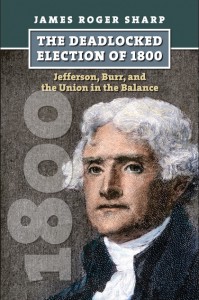A good overview of one of the most critical elections in American history

American politics today is frequently criticized for its divisiveness, its nastiness, and the way it polarizes the population. Yet this is hardly a new development, as many of those elements were on display in the early years of the republic as well. Back then the men who are canonized in the popular imagination today as the "Founding Fathers" engaged in political warfare even more vicious and bitter than what Americans decry today. Nothing demonstrates this better than the presidential election of 1800, which James Roger Sharp argues was one of the two most important elections in American history — and was fought as one by all of the people involved in it.
Sharp situates his account of the election in the politics of the 1790s. This was the beginning of the "first party system," when the Federalist and the first Republican parties emerged to promote their respective visions of the new nation. While the Federalists dominated during this period, Sharp notes that what really distinguished this period from any other in American political history was that the concept of legitimate contested opposition had yet to establish itself. This added to the divisiveness of politics of the time, as many Federalists did not hesitate to use the instruments of government to prosecute their Republican opponents as enemies of the state. Making this argument was easier given the international political situation of the time, as the ongoing conflict between Great Britain and France in the 1790s fueled the political polarization and cast the shadow of war over the country. In these circumstances it was easy for the Federalists to pass laws that could be used to attack Republican newspaper publishers and even threaten Republican members of Congress.
Further complicating the situation was infighting within the Federalist Party itself. Though John Adams was the president, many Federalists looked to Alexander Hamilton as their party's true leader. Dissatisfied with the prospect of an Adams presidency, Hamilton even attempted to engineer the election of his vice presidential nominee, Thomas Pinckney, as the president in 1796, a gambit that ended with Adams's opponent Thomas Jefferson winning the vice presidency. The election of 1800 was a rematch between the two candidates, and was fought out over the course of 1800. Sharp details the events in the various states that determined the election, which was not a contest between the two men for the popular vote but a more indirect battle within the states over choosing the electoral college delegation. This Jefferson's supporters won, only for some desperate Federalists to try to engineer the election of his running mate Aaron Burr — who through a quirk was in the balloting as well and possessed the same number of votes — instead. It was only through Hamilton's strenuous efforts, coupled with a declaration by a Federalist senator that Jefferson would preserve the Federalist system of government, that Jefferson emerged the winner, effecting the first successful exchange of power between presidents of different parties.
As a scholar of early American political history, Sharp brings to the book an extensive knowledge of the period and the scholarship on his subject. This he employs to craft a study that clarifies the very different politics of the era, which helps to explain both the election and its outcome. Because of this, it is a good book for anyone seeking a guide to a very different type of presidential contest than the ones they are familiar with today, one in which politics was more personal and opposition often fought simply to establish its legitimacy.






